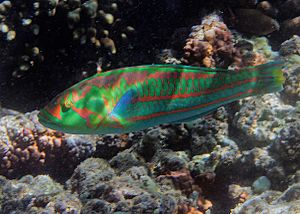Surge wrasse facts for kids
Quick facts for kids Surge wrasse |
|
|---|---|
 |
|
| Conservation status | |
| Scientific classification | |
| Synonyms | |
|
The surge wrasse (Thalassoma purpureum) is a colorful fish found in warm ocean waters. It's also known by other names like the green-blocked wrasse or purple wrasse.
This fish lives in the southeast Atlantic Ocean, the Indian Ocean, and the Pacific Ocean. You can find it around reefs and rocky shores. It prefers areas where waves are strong, from the surface down to about 10 meters (33 feet) deep. People sometimes catch the surge wrasse for local fishing or for fun. It can also be seen in aquariums.
Contents
What Does the Surge Wrasse Look Like?
The surge wrasse has a body that is quite deep and flattened from side to side. It has special teeth at the front of its bottom jaw. This fish can grow up to 46 centimeters (18 inches) long and weigh about 1.2 kilograms (2.6 pounds).
Colors of the Surge Wrasse
This wrasse is very colorful!
- Female surge wrasse: They are usually greenish. Their snout (nose area) has a dark red V-shape mark.
- Male surge wrasse: They are greenish-blue. They have two bright reddish stripes along their sides. Their head is large and blunt, also greenish-blue with pinkish-purple patterns.
The surge wrasse looks a lot like the ladder wrasse. Female surge wrasse are especially similar to female ladder wrasse. However, the surge wrasse has a bigger head and no spots on its head.
Fins of the Surge Wrasse
Like other fish, the surge wrasse has fins to help it swim. Its dorsal fin (on its back) has 8 strong spines and 12-14 soft rays. Its anal fin (on its belly) has 3 spines and 10-12 soft rays.
Where Does the Surge Wrasse Live?
The surge wrasse lives across a very wide area called the Indo-Pacific region. This area includes parts of the southeastern Atlantic Ocean, like the coast of South Africa.
In the Indian Ocean, you can find it from the Red Sea down to South Africa. It also lives around islands and coasts of Asia. In the Pacific Ocean, its range goes north to Japan and south to places like Lord Howe Island and the Kermadec Islands. It even reaches as far east as Panama in the eastern Pacific.
Life and Habits of the Surge Wrasse
As its name suggests, the surge wrasse loves areas with strong waves. It lives in the "surge zone" of outer reef flats and along the edges of coral and rocky reefs. It usually stays in water less than 10 meters (33 feet) deep.
Social Life and Diet
Surge wrasse live in groups. These groups are mostly made up of females spread out over large parts of the reef. A few much larger males dominate these groups.
The surge wrasse is a carnivore, meaning it eats other animals. It hunts small invertebrates like crabs, sea urchins, brittlestars, and molluscs. It also eats small fish and polychaete worms.
Reproduction and Life Cycle
The surge wrasse is a special kind of fish called a protogynous hermaphrodite. This means that all surge wrasse are born as females. Later in their lives, some females can change sex and become males. They release their eggs and sperm into the open water, a process called "pelagic spawning."
History and Discovery
The surge wrasse was first officially described in 1775. A Swedish naturalist and explorer named Peter Forsskål gave it the scientific name Scarus purpureus. He found it near Jeddah. Later, in 1839, another scientist named William Swainson created the genus Thalassoma and chose Scarus purpureus as the main example for this group of fish.
See also
 In Spanish: Thalassoma purpureum para niños
In Spanish: Thalassoma purpureum para niños


